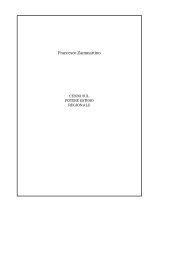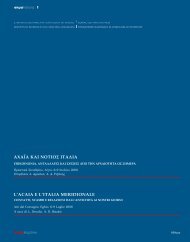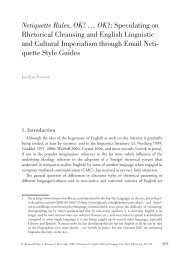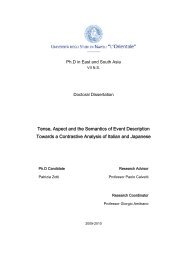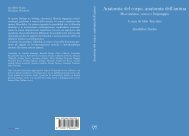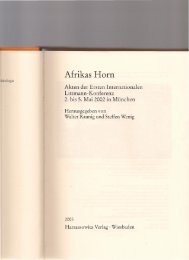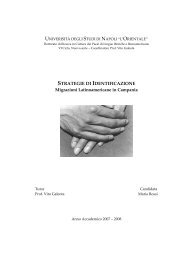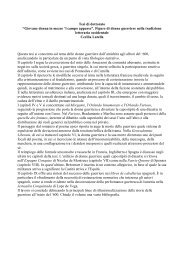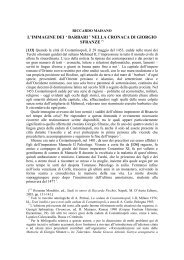Leonardo da Vinci. L'“angeLo incarnato” - OPAR L'Orientale Open ...
Leonardo da Vinci. L'“angeLo incarnato” - OPAR L'Orientale Open ...
Leonardo da Vinci. L'“angeLo incarnato” - OPAR L'Orientale Open ...
You also want an ePaper? Increase the reach of your titles
YUMPU automatically turns print PDFs into web optimized ePapers that Google loves.
“Map of Elephanta in India”:<br />
The “Angel in the Flesh” as Shiva-Dionysios*<br />
<strong>Leonardo</strong> <strong>da</strong> <strong>Vinci</strong> was perhaps the only one among those<br />
artists who was endowed with a truly over-Christian<br />
outlook. He knows well the East, both the inner and the<br />
outer one. There is something ‘extra-European’ in him,<br />
something not told and typical of those with an all too<br />
broad vision of good and bad things.<br />
F. Nietschke, Posthumous Fragment (1884-1885)<br />
ON THE inside of the second cover of Ms. F, among the<br />
various and casual writings as normally piling up both at<br />
the beginning or at the exit of that veritable textual labyrinth<br />
that <strong>Leonardo</strong>’s manuscripts are made of, there is an enigmatic<br />
note: “piata dellefante dindia chella antonello / mercaio ”.<br />
In English translation: “The plan of Ellefante in India, which<br />
Antonello the haber<strong>da</strong>sher has”.<br />
When was this written? In the same page, after the space of a line,<br />
we find the record of money loaned to Salaì: “A dì ... d’ottobre<br />
1508 ebbi scudi 30 / 13 ne prestai a Salai per compiere la dota alla<br />
sorel/la e 17 ne restò a me” (“On the <strong>da</strong>y ... of October 1508 I received<br />
30 scudi, 13 of which I loaned to Salai I borrowed 12 to Salaì<br />
so that he could complete his sister’s dowry, and 17 remained to<br />
me”), followed by a curious rhyme on all-too-easy loans. On f. 1<br />
r <strong>Leonardo</strong> records the <strong>da</strong>y when he began writing in that manuscript:<br />
“Cominciato a Milano addì 12 di settembre 1508” (“begun<br />
in Milan on the 12th of September 1508”). The Ellefante note,<br />
however, seems slightly different in ductus, and could well have<br />
been a later addition, as it is often the case with this kind of records.<br />
About the interpretation, we should dismiss the early Ravaisson<br />
Mollien fancyful reading of the Italian word “pianta” as referring<br />
to the foot of an Indian elephant; or a strange plant from India,<br />
or the Elephant Mountain in Siam) 1 , and look at the most likely<br />
* This is an up<strong>da</strong>ted version of a paper on <strong>Leonardo</strong> <strong>da</strong> <strong>Vinci</strong> and India, which I gave at<br />
the Indira Gandhi National Center for the Arts in New Delhi on October 12, 2004, and<br />
presented again in a seminar given at the Ja<strong>da</strong>vpur University in Kolkata on October 16 of<br />
the same year. I should like to mention Patrizia Raveggi and Supriya e Sukanta Chauduri,<br />
most generous with advices and suggestions on both those occasions. And above all Carlo<br />
Pedretti, who kindly put his library and archives in Los Angeles at my disposal.<br />
1<br />
Les manuscrits de Léonard de <strong>Vinci</strong>, ed. by C. Ravaisson-Mollien, vol. IV, Paris, 1889, ad<br />
locum: “Elephanta <strong>da</strong>ns l’Inde anglaise (îlot du golfe de Bombay), ou: Plan (ou Plante) de<br />
l’éléphant de l’Inde”. In the Pedretti library in Los Angeles there is a copy of this edition<br />
formerly owned and annotated by the German scholar Emil Möller, who wrote in the<br />
margin: “Caro Benedetto ... per <strong>da</strong>rti”, obviously a reference to the letter to Benedetto<br />
Dei. A note by Carlo Pedretti, just below, rejects the hypothesis: “impossibile, perché la<br />
lettera al Dei è del 1490 circa.”. It is inexplicable the text in the English translation by Jean<br />
Paul Richter in the first edition of his anthology The literary works of <strong>Leonardo</strong> <strong>da</strong> <strong>Vinci</strong>,<br />
London, 1883, § 1471: “Pianta d’Elefante d’India che à Antonello Merciaio <strong>da</strong> maestro Maffeo;<br />
perché 7 anni la terra alza e 7 abbassa; – cerca di Vetruvio fra cartolaj”; in translation:<br />
meaning: the “pianta of Ellefante” should be a plan or ground plan<br />
(the word “pianta” was already used in contemporary artistic and<br />
architectural lexicon), and therefore the map of a place in India<br />
called ‘Ellefante’ 2 . This place does in fact exists, the island of Garapur<br />
in the bay of Mumbai, first called by the Portuguese “Elephanta”<br />
because of a big statue of an elephant, now lost. All commentaries<br />
to this <strong>Leonardo</strong> note stop here. Only Solmi adds the suggestive<br />
text of a nineteenth century French traveller, and links the<br />
name of Elephanta to an odd description of a temple in Codex<br />
Atlanticus (f. 285 r-c [775 v]) 3 . As far as I know, the only scholar<br />
to raise the questiuon as to what <strong>Leonardo</strong> could have learned<br />
about India from a ‘map’ or a written account is Carlo Pedretti,<br />
who has endeavored to study the question in depth in his Richter<br />
Commentary 4 ; and who began to examine the reproductions of<br />
Elephanta sculptures, as shown by some his drawings <strong>da</strong>ting back<br />
to 1959-1960. As we know, <strong>Leonardo</strong>’s keen interest on the Orient<br />
came first from his relationship in Milan with a great Florentine<br />
traveller in Eastern Mediterranean Sea, Benedetto Dei, a merchant<br />
and agent of many affairs, addressee of a strange written report of<br />
a journey to the Middle East feigned by <strong>Leonardo</strong> around 1490.<br />
Another feigned letter to a “Dio<strong>da</strong>rio di Soria” (the Governor of<br />
Syria), a description of Mount Taurus and of a terrifying natural<br />
disaster, should have been written almost twenty years later 5 .<br />
“ Map of Elephanta in India which Antonello Merciaio has from maestro Maffeo; there<br />
for seven years the earth rises and for seven years it sinks. Enquire at the stationers about<br />
Vitruvius.”. The mistake was corrected in the later editions (Oxford, 1939; London, 1970).<br />
For the English edition of Ms. F, see Ente Raccolta <strong>Vinci</strong>ana. , The manuscript of <strong>Leonardo</strong> <strong>da</strong><br />
<strong>Vinci</strong> in the Institut de France. Translate and annotated by John Venerella: Manuscript F, Milan,<br />
2002. <strong>Leonardo</strong>’s note on the Map of Elephanta is on p. 176.<br />
2<br />
C. Vecce, <strong>Leonardo</strong>. Presentazione di Carlo Pedretti, Rome, 2006, p. 288.<br />
3<br />
E. Solmi, Scritti vinciani. Le Fonti dei Manoscritti di <strong>Leonardo</strong> e altri studi, Florence, 1976, pp.<br />
140-142.<br />
4<br />
National Gallery of Art. Kress Foun<strong>da</strong>tion studies in the History of European Art: The<br />
Literary Works of <strong>Leonardo</strong> <strong>da</strong> <strong>Vinci</strong> Compiled and Edited from the Original Manuscripts by Jean<br />
Paul Richter. Commentary by Carlo Pedretti, Oxford, 1977, Vol. II, p. 369.<br />
5<br />
<strong>Leonardo</strong> <strong>da</strong> <strong>Vinci</strong>, Scritti, ed. by C. Vecce, Milan, 1992, pp. 165-167 e 168-171. About the<br />
letter to Dio<strong>da</strong>rio, see F. Di Teodoro, “ ‘Stupen<strong>da</strong> e <strong>da</strong>nnosa maraviglia’ ”, in Achademia<br />
Leonardi <strong>Vinci</strong>, II, 1989, pp. 21-26. <strong>Leonardo</strong>’s drafts of a letter on a feigned journey to the<br />
East made Richter believe that the journey was not a fiction. See J.P. Richter, “Lionardo<br />
<strong>da</strong> <strong>Vinci</strong> im Orient”, in Zeitschrift für bildende Kunst, XVI, 1881, pp. 133-141; even if based<br />
on a mistaken hypothesis, his essay remains an important contribution to the study of<br />
<strong>Leonardo</strong>’s relation to the Orient, later confirmed by the discovery of direct contacts with<br />
Turkish civilization, e.g a letter to the sultan Baiazet II with the proposal of a bridge over<br />
the Golden Horn next to the Bosphorous at Constantinople, a project also hinted at in MS.<br />
L, f. 66 r; some Turkish words in Arabic writing in MS. M, f. 122 r; the fragment of a Turkish<br />
poem in CA, f. 103 r-a [283 r]). Cfr. Vecce, <strong>Leonardo</strong>, pp. 225-227. The theme of <strong>Leonardo</strong><br />
and India is approached by other authors, but with no important contributions, e.g. G.<br />
De Lorenzo, <strong>Leonardo</strong> e l’India, in Per il IV Centenario della morte di <strong>Leonardo</strong> <strong>da</strong> <strong>Vinci</strong>, a c.<br />
dell’Istituto di Studi <strong>Vinci</strong>ani in Roma diretto <strong>da</strong> Mario Cermenati, Bergamo, 1919, pp. 33-<br />
38; <strong>Leonardo</strong> <strong>da</strong> <strong>Vinci</strong>. Catalogo della mostra. Ambasciata d’Italia a Nuova Delhi, Rome, 1986.<br />
“Ma p o f El e p h a n ta in In d i a”<br />
369



